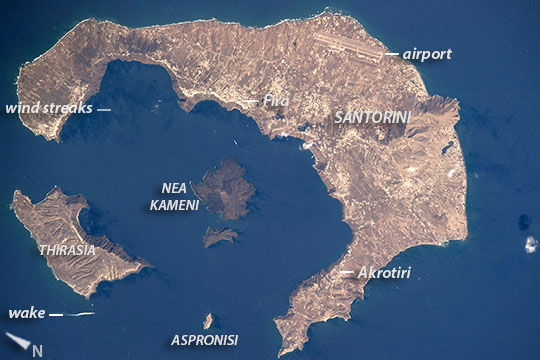
 Photo #: ISS048-E-72284 Date: Sep. 2016
Photo #: ISS048-E-72284 Date: Sep. 2016Geographic Region: GREECE
Feature: SANTORINI, THIRASIA, NEA KAMENI, THERA

 Photo #: ISS048-E-72284 Date: Sep. 2016 Photo #: ISS048-E-72284 Date: Sep. 2016Geographic Region: GREECE Feature: SANTORINI, THIRASIA, NEA KAMENI, THERA |
 |
| Santorini, Greece The outer islands in this detailed astronaut view are arranged in an oval shape: they are all that remains of a large circular volcano. Taken from the International Space Station, the image shows the largest island is the tourist mecca Santorini (also known as Thira) with an airport on the east side. The other islands making the ring are Thirasia (at image top right) and small Aspronisi (at image top center). This ring marked the what was once a volcanic cone making a single island. Santorini is essentially what remains after an enormous volcanic eruption destroyed most of the island. Water from the Aegean Sea rushed in to fill the void, making the central, 12 km-long (7.5 mi) lagoon. The lagoon is surrounded by high, steep cliffs on three sides (300 m, 980 ft). Several towns occupy the top of these impressive, near-vertical cliffs, appearing as white stipple from the traditional whitewash paint that is almost exclusively used on these islands. The wake of a boat moving south appears between Thirasia and Aspronisi. Ships arrive at the landing stage at the bottom of the cliffs near the main town of Fira (at image lower center). Tourists then climb the switchback road up the cliffs to the town--the classic Greek village on a cliff face looking out into the great lagoon. Santorini is described as one of the most famous tourist islands on Earth. The caldera explosion that made this lagoon is one of the largest known, estimated at 100 km3 of material blown away by the explosion. This is four times as much as the well-recorded eruption by Krakatoa in 1883. With this historical significance the date of the explosion has been carefully researched and is now known to have taken place between 1600 and 1627 BCE. Archeological excavations at the town of Akrotiri (at image left) are revealing exciting remains of a Minoan-age town with streets, three-storey houses and frescoes well preserved under ash the layers, much like those preserved at Pompeii. As an active volcano, the central peak has grown and then erupted repeatedly. The most recent peak of the underwater volcano appeared above water as the island of Nea Kameni in the middle of the lagoon in 1707. This undersea volcano is the current center of volcanic activity. Eruptions continue here with three in the twentieth century alone. Recent lava flows on the island appear as dark-toned areas, compared with the older lighter-toned surfaces of the outer islands. A detailed astronaut image of part of Santorini and Nea Kameni taken in 2008 can be seen here (ISS017-E-5037). Santorini has been designated a Decade Volcano because it poses more than one volcanic hazard to people living near it. Another Decade Volcano is Sicily's Mount Etna, 400 km to the west of Santorini, whose more frequent eruptions are often photographed by astronauts (ISS005-E-19024). |
| Images: | All Available Images Low-Resolution 81k |
|
| Mission: | ISS048 |
|
| Roll - Frame: | E - 72284 |
|
| Geographical Name: | GREECE |
|
| Features: | SANTORINI, THIRASIA, NEA KAMENI, THERA |
|
| Center Lat x Lon: | 36.4N x 25.4E |
|
| Film Exposure: | N=Normal exposure, U=Under exposed, O=Over exposed, F=out of Focus |
|
| Percentage of Cloud Cover-CLDP: | 10 |
|
| Camera:: | N6 |
|
| Camera Tilt: | 23 | LO=Low Oblique, HO=High Oblique, NV=Near Vertical |
| Camera Focal Length: | 800 |
|
| Nadir to Photo Center Direction: | W | The direction from the nadir to the center point, N=North, S=South, E=East, W=West |
| Stereo?: | Y=Yes there is an adjacent picture of the same area, N=No there isn't |
|
| Orbit Number: | |
|
| Date: | 20160903 | YYYYMMDD |
| Time: | 104902 | GMT HHMMSS |
| Nadir Lat: | 36.3N |
Latitude of suborbital point of spacecraft |
| Nadir Lon: | 26.9E |
Longitude of suborbital point of spacecraft |
| Sun Azimuth: | 199 | Clockwise angle in degrees from north to the sun measured at the nadir point |
| Space Craft Altitude: | 216 | nautical miles |
| Sun Elevation: | 60 | Angle in degrees between the horizon and the sun, measured at the nadir point |
| Land Views: | ISLAND, VOLCANO |
|
| Water Views: | LAGOON, SEA |
|
| Atmosphere Views: | |
|
| Man Made Views: | AIRPORT |
|
| City Views: | |
|
Photo is not associated with any sequences | ||
| NASA Home Page |
JSC Home Page |
JSC Digital Image Collection |
Earth Science & Remote Sensing |
|
|